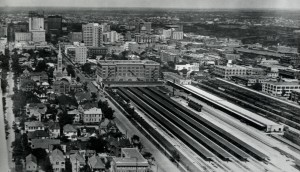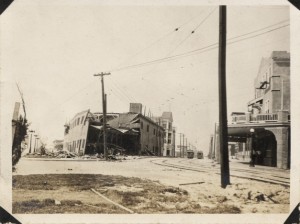
On this day in 1960, Houston was awarded a National League expansion team. That team, first called the Colt .45s, played its first game nearly two years later, on April 10, 1962. In 1965, with the opening of the Astrodome, the team became the Astros.
A major factor in bringing major league baseball to Houston was the work of the Houston Sports Association, whose detailed plans included a scale model of the Astrodome. The association was formed in 1957 by a group of men that included sportswriter, traveler, and baseball promoter George Kirksey. Kirksey held the position of Vice President of the Houston Sports Association until 1966. During that time he was instrumental in the promotion of the team and the Astrodome.
Special Collections holds the George Kirksey Papers, which include a variety of materials dealing with Kirksey’s work as part of the Houston Sports Association. These materials include press kits, correspondence, newspaper clippings, and photographs.
Today marks the last day of the Houston Astros‘ season, one that will go down as the team’s worst season to date regardless of the outcome of tonight’s game. It was a season that was historic in a way that teams don’t like to brag about, and as a relatively new team — they played their first season as the Houston Colt .45s in 1962 — the Astros don’t have a lot of history to look back on.
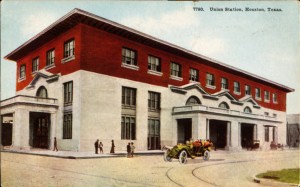
A postcard of Union Station in Houston long before the Astros started playing baseball on the grounds.
One aspect of the team that is worth talking about is the history that lives on in its 11-year-old ballpark. That’s right, history in a ball park that hasn’t even reached its adolescence. Most fans outside of Houston know the stadium as Minute Maid Park (or, in it’s former life, Enron Field), but the locals also know it as the Ballpark at Union Station. That’s because the stadium was built on the site of Union Station, a railway station located at Crawford Street between Texas Avenue and Congress Avenue that was dedicated on March 2, 1911. The railroad was vital to Houston’s growth and development, and Union Station was a key factor. Today, what was the station’s main concourse is now both the main entrance to the stadium and home to a conference center and executive offices. Astros team officials say that approximately 60 percent of fans enter the stadium through the Union Station lobby.
UH Special Collections holds photographs and illustrations of the original Union Station in the George Fuermann “Texas and Houston” Collection, which you see in this post, and which are also a part of the UH Digital Library. For a view of what Union Station looks like today, check out this picture from Wikimedia Commons.
If you’d like to know more about the renovation of Union Station as part of the building of the stadium, take a look at this article from the Houston Railroad Museum.
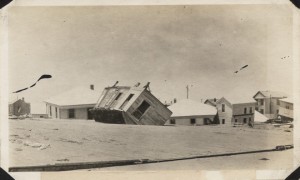
Wrecked houses submerged in sand on the east of Galveston on Seawall Boulevard after the 1915 hurricane.
The Texas Gulf Coast could use the rain that a small tropical system would bring, but the threat of a hurricane hitting the Houston-Galveston area has likely — most would say, thankfully — passed for this year. Mid-September sees the peak activity of the Atlantic hurricane season, which officially ends on November 30.
Many people know about the famous Hurricane of 1900, which hit Galveston on September 8, 1900. This large, powerful storm was responsible for the deaths of tens of thousands of people and holds the record as the deadliest natural disaster to ever strike the United States.
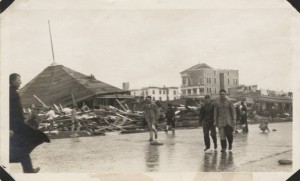
After the 1915 hurricane, pedestrians walk along the Seawall with wreckage from Murdoch's Bathhouse in the background.
Following the storm, in 1902 construction started on the Galveston Seawall, meant to protect the city from future storm surges. Additionally, the elevation of the island was raised by up to 17 feet. These protective measures were tested in 1915, when on August 16 a devastating hurricane hit the island. In contrast to the 1900 storm, only 275 deaths were attributed to the 1915 hurricane. This low death toll, especially in contrast to the Hurricane of 1900, was attributed in large part to the protection given by the Seawall.
UH Special Collections has a collection of photographs of the 1915 storm’s damage. The photographs were taken by Rex Dunbar Frazier, an engineering representative called in to collect storm damage data and photographs. These photographs document the damage to streets, railroads and buildings and repairs in progress. The photographs can be viewed in the Special Collections Reading Room, or take a look at them in the UH Digital Library.
The new exhibit Leon Hale: A Texas Journey opens on March 1, 2007. Drawn from materials in the Leon Hale Papers, the exhibit traces the life and career of Hale, a journalist, essayist, and fiction writer best known for his folksy columns in the Houston Post and Houston Chronicle. The exhibit will be on view on the 1st and 2nd floors of M.D. Anderson Library through August 23, 2007.
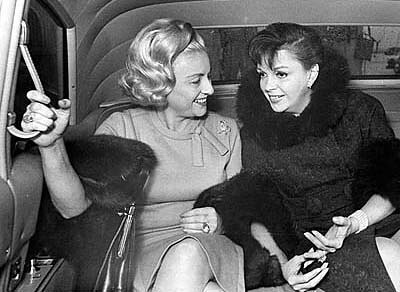
Once again, the collections represented in this week’s crop of of new finding aids represent some far-reaching aspects of the history of Houston, Texas, and beyond.
Maxine Mesinger Papers, 1965-2001
Special Collections holds the papers of the late great Houston society columnist Maxine Mesinger. Mesinger, also known as "Miss Moonlight", wrote the "Big City Beat" column for the Houston Chronicle. At her memorial service, Liz Carpenter eulogized "She was the last of the dot dot dot girls". Our holdings include the entire run of the "Big City Beat" column, Mesinger’s personal photo collection and an audio tribute from Joan Rivers!
Mexico Documents Collection, 1570 – 1898
Moving right along, I’ve put up the finding aid for this collection, which is really just a broad assortment of historical materials from Mexico. Translations are available for many of the documents. If you are a UH Faculty member, student, or any other community member with an interest in historic documents from the US-Mexico border region, get in touch with me. We have an even larger collection of materials, and they’re very underresearched.
More items unearthed from our unprocessed Manuscripts:
Paul Alexander Bartlett Letter, 1933
A letter from writer and artist Paul Alexander Bartlett asking for educational support from philanthropist Anita McCormick Blane. The Benson holds a collection of Bartlett’s photos.
This document details a skilled worker’s entry to Cuba.
Letter from the modernist architect and designer Marcel Breuer, written from New York City to University of Houston Professor of Architecture Howard Barnstone. October 12, 1971. Regards letter from Barnstone asking for support in Hugo V. Neuhaus Jr.’s nomination to the AIA College of Fellows.
Photo: Maxine Mesinger with Judy Garland. Photo dated Dec. 15, 1965. Houston Chronicle File Photo
